Honor Award
Achieving the Goal of 25% Canopy Coverage in Phoenix by 2030.
David Fowler, Student ASLA, Graduate, Arizona State University
Faculty Advisors: Joseph Ewan, ASLA and Kenneth Brooks, FASLA
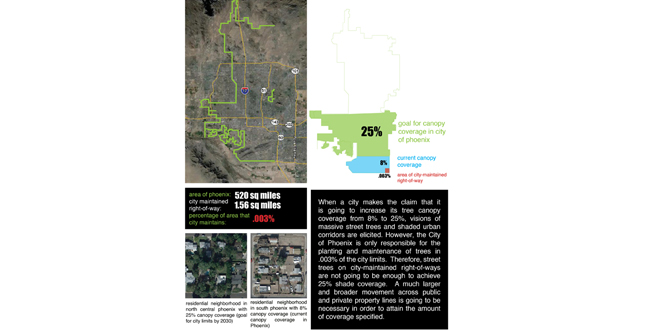 Close Me!
Close Me!When a city makes the claim that it is going to increase its tree canopy coverage from 8% to 25%, visions of massive street trees and shaded urban corridors are elicited. However, the City of Phoenix is only responsible for the planting and maintenance of trees in .003% of the city limits. Therefore, street trees on city-maintained right-of-ways are not going to be enough to achieve 25% shade coverage. A much larger and broader movement across public and private property lines is going to be necessary in order to attain the amount of coverage specified.
Download Hi-Res ImageImage: David Fowler
Image 1 of 15

 Close Me!
Close Me!Lifecycle of Trees in Urban Environments — A large tree produces 60-70 times the ecological benefits of small trees.
Download Hi-Res ImageImage: David Fowler
Image 3 of 15
 Close Me!
Close Me!Cornell Structural Soil® vs. Non-Structural Soil — Cornell Structural Soil was created to address the issue of lack of rootable space for trees in urban environments while providing areas that can be compacted for sidewalks and plazas. Soil sits between angular broken gravel and the roots can pass through these voids created from the contact points of the stones.
Download Hi-Res ImageImage: David Fowler
Image 4 of 15
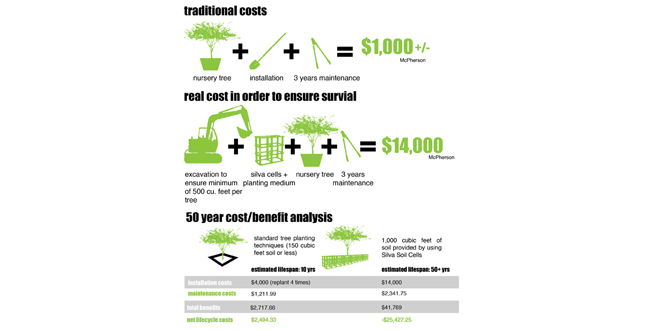 Close Me!
Close Me!What does it really costs to grow a tree that will reach its full potential canopy size?
Download Hi-Res ImageImage: David Fowler
Image 5 of 15
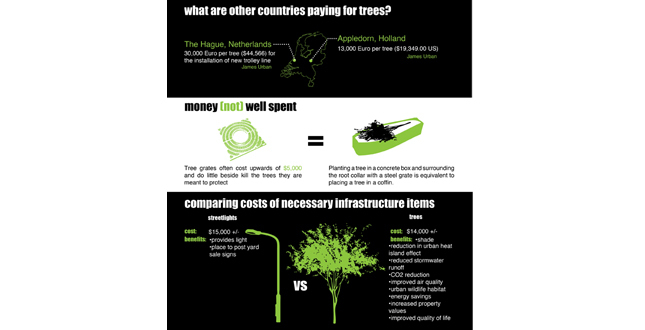
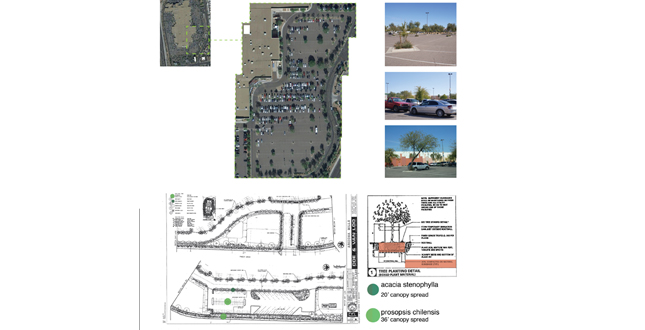 Close Me!
Close Me!Arizona Mills, Tempe: Large Commercial Parking Lot Case Study — The planting plan and planting details were used to compare expected canopy sizes to actual canopy sizes 13 years after installation.
Download Hi-Res ImageImage: David Fowler
Image 7 of 15
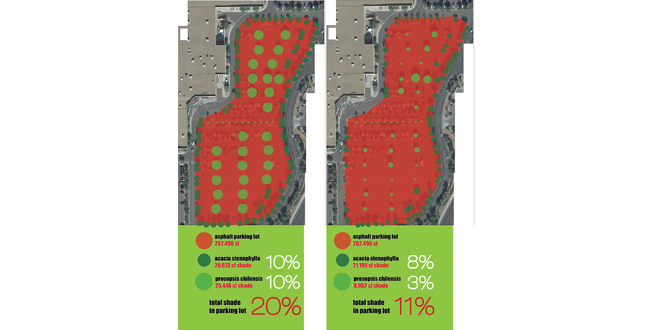 Close Me!
Close Me!Arizona Mills, Tempe: Large commercial parking Lot Case Study
Download Hi-Res ImageImage: David Fowler
Image 8 of 15
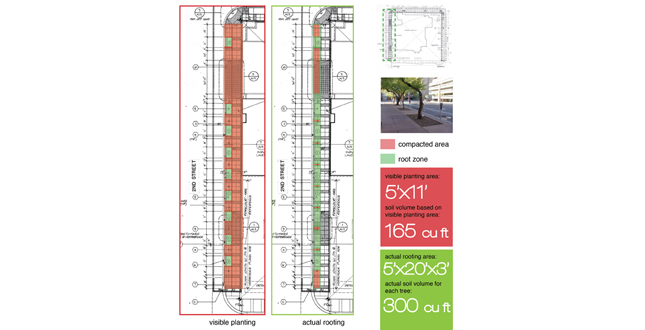 Close Me!
Close Me!Herberger Theater Center: Downtown Phoenix Street Tree Case Study
Download Hi-Res ImageImage: David Fowler
Image 9 of 15
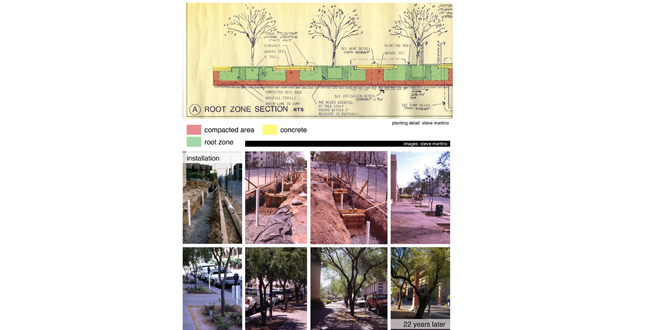 Close Me!
Close Me!Herberger Theater Center: Downtown Phoenix Street Tree Case Study
Download Hi-Res ImageImage: David Fowler
Image 10 of 15
 Close Me!
Close Me!Ten Eyck Parking Lot: Small Commercial Parking Lot Case Study — In 2001, Ten Eyck Landscape Architecture renovated an old asphalt parking lot to create parking garden with permeable pavers and crushed granite interplanted with mesquite trees. The design for this parking lot can be a model for use of pervious materials in parking lots to decrease stormwater runoff and dramatically increase the amount of shade in parking areas.
Download Hi-Res ImageImage: David Fowler
Image 11 of 15
 Close Me!
Close Me!Recommendation #1: Update City Planting Details — current planting detail for the City of Phoenix: a) Planting pit is only 2x size of rootball. If soil outside of rootball is compacted, rootable area for tee may only be 50 cubic feet (based on 24” box tree). B) According to "Arboriculture" 4th Edition, wire should never be used to stake a tree, and hose-covered wire is inadequate to prevent injury.
Download Hi-Res ImageImage: David Fowler
Image 12 of 15
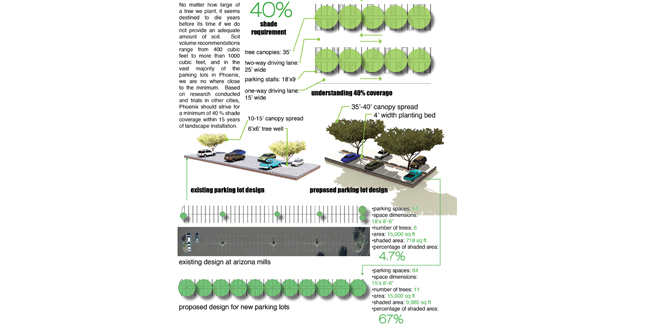 Close Me!
Close Me!Recommendation #2: New Parking Lot Ordinances — No matter how large of a tree we plant, it seems destined to die years before its time if we do not provide an adequate amount of soil. Soil volume recommendations range from 400 cubic feet to more than 1000 cubic feet, and in the vast majority of the parking lots in Phoenix, we are nowhere close to the minimum. Based on research conducted and trials in other cities, Phoenix should strive for a minimum of 40% shade coverage within 15 years of landscape installation.
Download Hi-Res ImageImage: David Fowler
Image 13 of 15
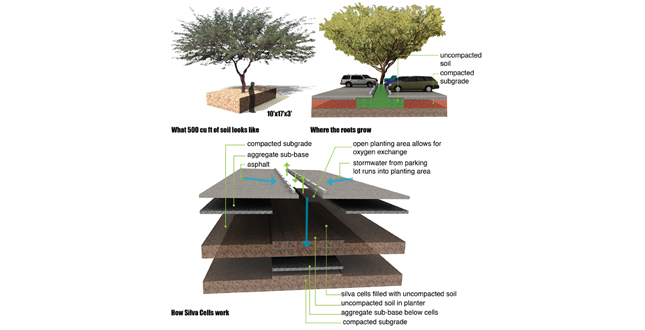 Close Me!
Close Me!Recommendation #2: New Parking Lot Ordinances — In order to achieve the goal of 40% shade coverage, trees will need a minimum of 500 cubic feet of soil per tree. Whenever possible, tree wells should be connected to extend rootable areas. It is time to recognized that 5'x5' tree diamonds surrounded by compacted soil are not hospitable environments for trees, and 40' tree canopies drawn on planting plans will never be achieved with these conditions.
Download Hi-Res ImageImage: David Fowler
Image 14 of 15
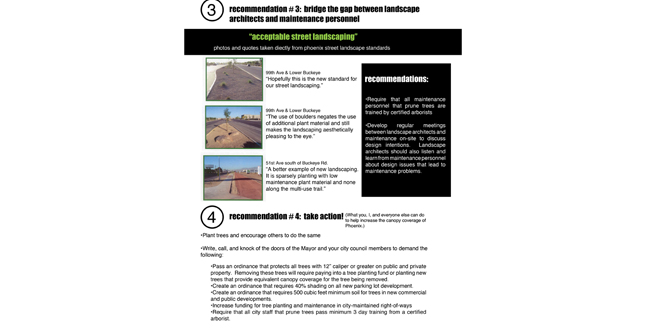 Close Me!
Close Me!Recommendation #3: Bridge the gap between landscape architects and maintenance personnel — Require that all maintenance personnel that prune trees are trained by certified arborists. Develop regular meetings between landscape architects and maintenance on-site to discuss design intentions. Landscaped architects should also listen and learn from maintenance personnel about design issues that lead to maintenance problems. Recommendation #4: Take Action! (What you, I, and everyone else can do to help increase the canopy coverage of Phoenix).
Download Hi-Res ImageImage: David Fowler
Image 15 of 15
Project Statement
In 2009 the City of Phoenix set the goal to increase the tree canopy coverage of the city from its current 8-10% to 25% by the year 2030. This project investigates the realistic potential of the canopy coverage goal, and makes recommendations to the city based on research that can be used to help achieve the goal, as well as create a template for other cities to increase funding allocated to street trees.
Project Narrative
—2011 Student Awards Jury
The current state of street trees in Phoenix is tragic, but common in many cities around the United States. Trees in the city-maintained right-of-way are being removed faster than they are being planted, and those planted in dense urban areas generally have a lifespan of 10 years or less1. In 2007, Phoenix spent $3.48 per capita on tree planting whereas the average in the rest of the United States was $7.65 per tree2. Furthermore, over the past 4 years, over $30 million has been cut from the parks and maintenance departments, and there has been a 60-plus percent reduction in staffing for street landscape maintenance. With this dire situation, is the goal to triple the canopy coverage of Phoenix in 19 years realistic? The research and recommendations outlined in this project conclude that the goal is tenable, but dramatic changes to current practices and policies need to be adopted immediately.
Research about the benefits of street trees is common and easily accessible. The benefits range from improved air quality, decreased demand for energy, reduced stormwater runoff, mitigated urban heat island effect, increased wildlife habitat, and increased property values. What is not as common however, is a compelling argument to increase the amount of funding allocated to each tree that is planted to ensure its survival. The emphasis of this research was to investigate the amount of soil trees in urban areas need to reach their potential environmental and economic benefits, and present the information in with graphics that make the data understandable to the general public.
Methods
The investigation for this project began with compiling data from researchers around the country about the environmental and economic benefits of street trees. This data was further deciphered to understand the benefits of mature trees versus trees that only live 10 years (the approximate lifespan of most trees in dense urban areas).
The next type of research conducted involved tree protection laws around the country that could serve as models for the City of Phoenix to follow. This investigation describes tree protection laws in 5 other cities that have much stricter preservation laws and shade requirements than Phoenix.
The final phase of research investigated 3 case studies in the Phoenix area: a large outdoor commercial parking lot, a small commercial parking lot, and a block of street trees in downtown Phoenix. Planting plans from the landscape architects were used for each case study to compare the canopy sizes drawn on the plans with the mature tree sizes years after installation. Then, planting details and material choices were further studied to analyze why certain planting practices may have been more or less successful than others.
Results
Results from the case studies clearly demonstrated that larger rooting areas produce larger, healthier, and longer living trees.
Large Commercial Parking Lot: Based on the research from the large parking lot case study, it can be concluded that standard planting practices for large commercial parking lots do not provide a suitable environment for trees to reach their potential canopy sizes and ecological benefits. The diamond-shaped planting areas for the trees in this parking lot were 6’x6’ with a 6” curb. Estimating an excavation depth of 36”, these tree planting areas provide 108 cubic feet of uncompacted soil per tree. Thirteen years after planting, approximately one third of the trees planted in the study area had died and either been replaced or left with empty planting pits, and only one tree out of 29 trees planted in the square planting pits had reached its expected canopy size of 36 feet. The original shade estimation for the parking lot was 20% based on canopy sized drawn on the landscape architect’s planting plan. 13 years after installation, the parking had 11% shade coverage; 8% from the perimeter trees planting in large planting areas, and 3% from the trees in the center of the parking lot in the 6’x6’ planting diamonds.
Small Commercial Parking Lot: The use of porous pavers and stabilized decomposed granite provided excellent rooting and growing conditions for the trees on this property. This project was constructed in 2001 and specified Palo brea trees with 30’ canopies. Less than 10 years after installation, every tree planted had nearly reached its expected mature size, and the parking lot had 59% shade coverage.
Street Trees in downtown area: This case study provided the longest time range to observe the trees planted. The project was constructed before structural soil or Silva Cells were invented, but it used a low-tech and innovative approach to creating more rooting space for trees. The landscape architect was able to provide greatly enlarged rooting areas by digging large trenches for the trees and suspending the sidewalk over the trenches rather than digging individual planting holes. 22 years after installation, the trees have 30’+ canopies and several have 24”+ calipers. Compared to the vast majority of trees planted in downtown Phoenix, these trees are exceptionally large.
Conclusions
This research demonstrated a simple fact that most of us already know, but has apparently been forgotten by many landscape architects: “Trees need dirt” (as stated by James Urban). Based on the research conducted, the following recommendations were made to the City of Phoenix in order to achieve its goal of 25% shade coverage by 2030:
- Update the planting details used by the City of Phoenix. (Current planting details call for outdated planting practices such as the use of wire when staking trees, and only digging tree planting holes two times the size of the rootball).
- Pass an ordinance that requires all new parking lots to have 40% shade coverage within 15 years of construction. All trees planted in these parking lots will also be required to have a minimum of 500 cubic feet of soil in order to achieve their potential sizes and meet shade requirements. Tax incentives for surpassing the minimum shade requirements were also suggested, as well as enforcement during planning, construction, and years after the installation.
- Bridge the gap between city maintenance personnel and landscape architects. Many trees in the city-maintained right of way are pruned into shapes that no longer resemble trees. Landscape architects are also responsible for specifying large trees in inappropriate areas that will require more maintenance than is realistic for city personnel. Therefore, landscape architects designing city projects should meet with maintenance personnel to discuss design intentions and to listen to potential concerns about maintenance issues resulting from the design.
Significance
Thanks to the work of James Urban and Greg McPherson, there is a large body of research data that supports that fact that trees in urban areas need more soil than we normally provide for them. The research conducted in this project further proves this assertion with case studies specific to the Phoenix area, but which can be applied to any city.
This project also quantifies the real cost of street trees and provides graphic economic and environmental lifecycle analysis’ that compare standard planting practices to those recommended by urban street tree experts such as James Urban. This data, put into an easily digestible format, was created to convince city council members and other key decision makers that cities such as Phoenix need to pass stricter ordinances to protect existing trees in the urban environment and create new ordinances that will dramatically increase shading in parking lots.
Although this project was designed specifically to address the goal Phoenix set to achieve 25% canopy coverage by 2030, the lessons learned can be applied to any city in the world that sets out to increase its canopy coverage.
Resources
1Urban, James.
2Tree City USA 2008 summary report
Additional Project Credits
Arizona State University
Joseph Ewan, Principal Academic Advisor;
Kenneth Books, Academic Advisor
City of Phoenix
Walt Kinsler, Landscape Architect;
Lysistrata Hall, Parks and Recreation Department; Ken Vonderscher, Deputy Director, Parks and Recreation; Richard Adkins, Forestry Supervisor; Gail Brinkman, Street Transportation Department
Steve Martino & Associates
Steve Martino
Coe & Van Loo Associates
Timothy Starkey, Project Manager
Center for Urban Forestry
Greg Mcpherson
Ten Eyck landscape architects
Roger Socha
City of Tucson
Irene Ogata, Urban Landscape Manager
Waibel & Associates
Janet Waibel






